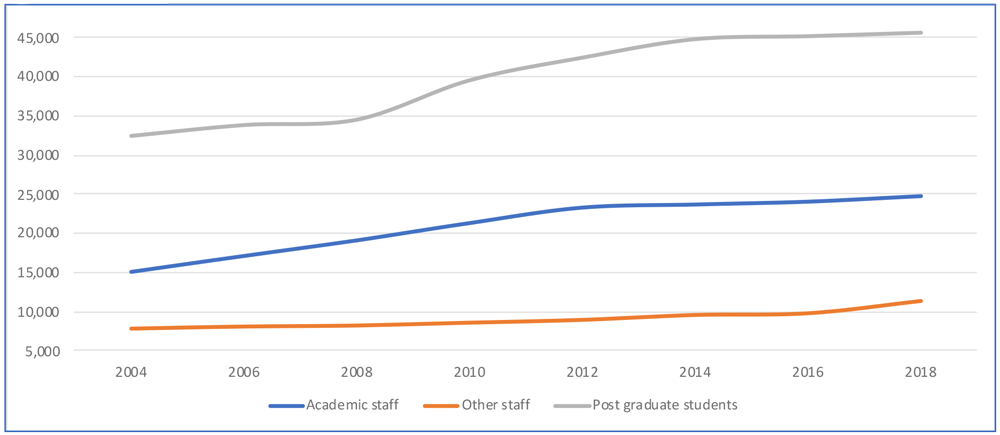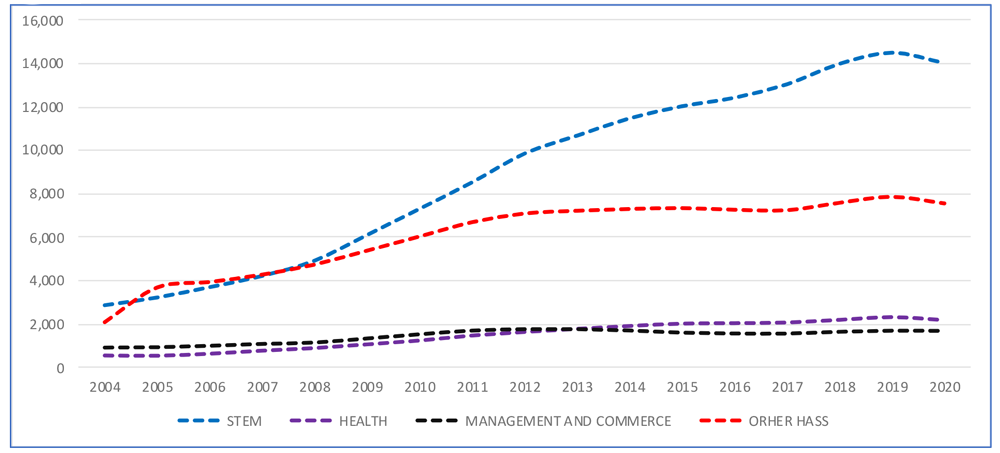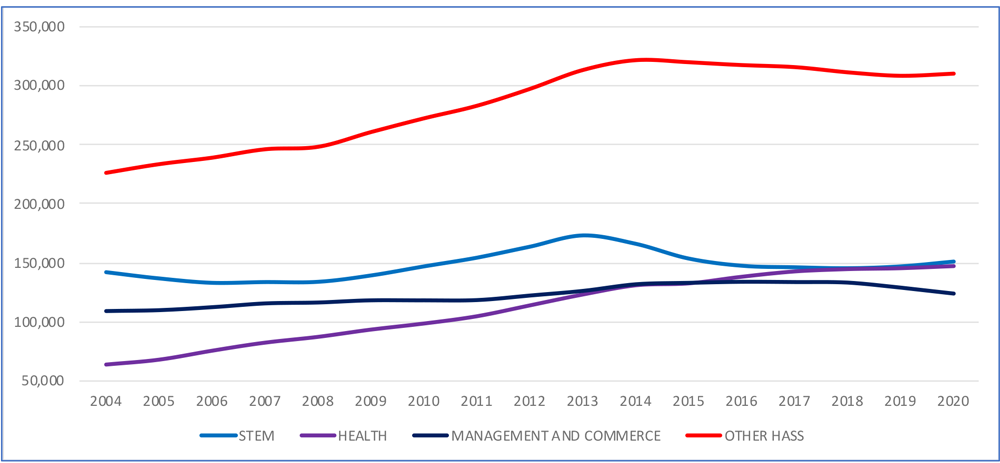
Media
Government concern with PhD numbers is well justified.
John H Howard
24 February 2022
On 31 January 2022, the Prime Minister announced that the Government would provide $2.2 billion for an 11-year University Research Commercialisation Action Plan (Department of Education Skills and Employment, 2022b) that would focus on priority areas of economic need. The Plan would encompass $1.6 billion for an “Australia’s Economic Accelerator” program, $243m for a startup Trailblazer program, and perhaps most significantly, $296m to fund 1,800 PhDs and fellowships in industry-focused disciplines.
The Government’s apparent concern with the requirement to boost PhD numbers is well placed, although it has not been widely reported. But the initiative may fail to achieve take-off unless potential students have greater confidence in their ability to build a secure postdoctoral career in either academia or industry – or both. Much more commitment to lifting university research capacity is required – even before the commercialisation process can start to work.
The current high level of casualisation in the postdoctoral academic workforce (Ross, 2022), the “sales culture” of much Australian business, and the declining interest of governments in evidence-based policy provide little basis for holding much confidence about career opportunities.
PhD students are an essential and growing component of the academic workforce that contributes to the higher education research and development (HERD) effort, which is, in turn, an essential component of Australia’s national R&D effort. The academic workforce makes up just under half of HERD.
In 2018, 55% of university research staff were postgraduate students. Academic staff made up 30% and other staff 15%. The numbers of PhD students increased rapidly from 2010, while numbers of academic staff flattened out from 2012.
Figure 1: Higher Education R&D human resources in research 2004-2018
PhD students and graduates sustain the academic workforce as they develop their (albeit casual) academic careers. Still, they also provide the talent for Australian industry innovation during their PhD programs or in employment after completion. Australia’s higher education and national research and development are at risk without a substantial increase in the flow of PhD graduates.
Recently released DESE student data (Department of Education Skills and Employment, 2022a) point to the nature of this risk. In 2020 there were 58,110 PhD students in Australian universities, much like in 2017 (58,102). Of the 2020 total, 36,514 were Australian domestic students, and 21,596 were international students. So far, so good.
But further inspection of the trends indicates that Australian domestic PhD enrolments have been in decline since 2017, when a total of 37,787 was recorded (a drop of 1,283 from 2017). The falls have been most pronounced in STEM (-395), HASS (-780) and Management and Commerce (-223). These reductions have been offset to some extent by increases in Health (+115).
Figure 2: Domestic PhD students in Australian universities
The decline in domestic PhD students may be associated with the transfer of responsibility for granting post-graduate financial assistance from the ARC to the universities under changes to the Research Training Program.
The University Research Commercialisation Action Plan may address this problem, but given the trends, an additional 180 PhDs and fellowships per year will have little impact. Much more commitment is required.
Since 2009 total university PhD enrolments have increased by almost a third (from 44,292). This growth has been almost entirely due to the international cohort. Most of the international growth has been in the STEM disciplines, accounting for 78.4% of the increase. The increases have been most substantial in the Natural and Physical Sciences and Engineering and Related Technologies, but less so in Information Technology and Agriculture and Environmental and Related Studies.
Trends in the growth of intentional PhD students studying in Australia is shown below.
Figure 3: International PhD students in Australian universities
While it is good to have international PhD students support the Australian national R&D efforts, the implications for Australian industry growth and prosperity are more worrying. In particular, international PhD students may be required under visa or sponsorship requirements to return to their home countries or advance their careers in other places after completion. Moreover, in the current national security climate, overseas countries may be less inclined to send PhD students to Australia. Finally, overseas students in some research fields may also be barred from undertaking studies in Australia under national security protocols.
The downward movement of international PhD students in 2020 is a cause for concern. Australia’s higher education and national research and development effort will be severely compromised if it continues. This means more action is required to lift Australia’s domestic capacity for doctoral research and post-graduate career opportunities.
PhD students publish widely and extensively with their academic supervisors in international journals to secure academic careers and tenure. Under current circumstances, these opportunities are not readily available in Australian universities due to a heavy reliance on long term casual postdoctoral employment. Prospects for tenured academic positions are limited in universities with an overriding concern about controlling their budgets.
More postgraduate employment opportunities may arise in government research organisations (Commonwealth and State), autonomous university research centres with substantial external income, and independent research institutes – as is the case with well-funded medical research institutes that can attract significant income through philanthropy and earmarked government funding pools (e.g. the MRFF).
Notwithstanding these institutional constraints, innovation and industrial policy should encourage Australian and international PhD students to stay in Australia to help grow Australian businesses or start their own. This should continue until Australia can substantially grow its own post-graduate workforce. The United States has developed this sort of initiative under the Biden Administration.
The distribution of Australian PhD effort has changed markedly since 2009: while the proportion of PhDs in STEM has remained the same at 38.0%, the proportion in Health has increased from 14.9% to 19.2%. This has occurred at the expense of Management and Commerce (down from 7.0% to 5.3%) and other HASS (down from 40.1% to 37.9%).
This picture points to the superior availability of funding for medical research from NHMRC, MRFF, and university own funds. Changes in the block granting arrangements can further shift PhDs towards STEM and away from Management and the other HASS disciplines. Block grant support is available to both domestic and international students.
But shifting the money around and the small number of PhD places available each year under the Commercialisation Action Plan will not solve Australia’s PhD deficit, but it is a good start.
If we are to increase the number of Australian PhD candidates, we must also look at the “pipeline” from undergraduate programs, particularly honours programs, that prepare students for postgraduate study.
Fortunately, the signs are encouraging. Although the number of Australian students enrolled in Bachelor pass degrees has fallen from 685,187 in 2014 to 668,315 in 2020, the number of students enrolled in Bachelor Hons courses has increased from 32,670 to 102,373 in 2020. The growth in Bachelor Hons degrees enrolments has been most substantial in the STEM fields – from 18,138 in 2014 to 59,157 in 2020. Health has also increased from 3,048 to 18,783 over the same period. Other HASS has also been strong, with growth from 12,571 to 30,302.
However, the growth in domestic enrolments in Bachelor Pass degrees (as a pre-cursor to honours degrees) faltered in 2014: STEM enrolments have fallen from 165,794 in that year to 151,016 in 2020; Management and Commerce from 131,083 to 121,636; and other HASS from 321,446 to 4 309,947. Health has lifted enrolments from 130,322 to 146,457. STEM enrolments appear to be recovering from the 145,426 recorded in 2018, possibly due to the Job Ready Graduates Package (Australia. Department of Education, 2020). The annual trends from 2004 to 2020 are shown below.
Figure 4: Australian domestic student enrolments – Bachelor Pass
Resolving the weaknesses in Australia’s postgraduate workforce requires institutional strengthening and increasing direct and indirect support for PhD and postdoctoral students. This will mean building stability and long-term commitment to the research infrastructure that will provide the setting for PhD and postdoctoral students to contribute to innovation through their acquired talents in strategic and applied research and grow their careers in either an academic or industry environment – and preferably both. This will require developing a number of actions including, but not limited to:
- Long term committed support for government research organisations to address and plan for high priority innovation opportunities involving the engagement of PhD and postdoctoral students.
- Committed and long-term infrastructure support for high-performance autonomous university research institutes and centres, particularly in engineering and technology, facilitating the development of PhD programs and postdoctoral research and industry engagement opportunities
- Investing in the creation of new permanent collaborative research institutes that involve the participation of universities and government research agencies and where PhD and postdoctoral programs are given high priority
- Encouraging high performing CRCs to continue after CRC grant funding runs out (after two rounds), thereby continuing their PhD and postdoctoral programs.
Stability and commitment also require establishing consistency and coherence across the multiple ministerial portfolios and agencies responsible for the copious number of funding pools (Howard, 2020, Green and Howard, 2015) and haphazard program funding commitments (Howard, In progress) in a framework of a National Public Research Investment Strategy.
The University Research Commercialisation Action Plan is a good start in this journey, but it does not support infrastructure development or continuity. As essentially a funding program, several critical questions emerge: What happens after 11 years when the money runs out? Will the Action Plan have contributed to a more robust research infrastructure and research workforce? How can the Plan stand above the “noise” in the current heavily flawed public research funding system? 5
The Action Plan in its current formulation looks tactical rather than strategic. Addressing the challenges for Australia’s innovation and industrial future will involve seeing the Plan as one instrument in a Public Research and Investment Strategy that addresses not only research commercialisation and collaboration but also addresses the urgent need to build the human resources capability that will grow and sustain Australia’s investment in higher education and national research and development commitment.
References
AUSTRALIA. DEPARTMENT OF EDUCATION, S. A. E. 2020. Job-ready graduates: higher education reform package 2020. Canberra: Department of Education, Skills and Employment.
DEPARTMENT OF EDUCATION SKILLS AND EMPLOYMENT 2022a. Selected Higher Education Statistics – 2020 Student data. Canberra: Department of Education Skills and Employment.
DEPARTMENT OF EDUCATION SKILLS AND EMPLOYMENT 2022b. University Research Commercialisation Action Plan. Canberra: Department of Education Skills and Employment.
GREEN, R. & HOWARD, J. H. 2015. Australia’s Innovation Future: A Report on the Structure and Performance of Australia’s National Innovation System, Attachment 1 to the Senate Economic References Committee Report on Australia’s Innovation System. Canberra: The Senate.
HOWARD, J. H. 2020. Challenges for Australian Research and Innovation. Sydney: University of Technology Sydney.
HOWARD, J. H. In progress. Investing in Australian public research and development: problems, challenges, and opportunities. Sydney.
ROSS, J. 2022. Dreaming the impossible dream. Times Higher Education. London.
Recent Posts
- Technical skills not enough for constant innovation
InnovationAus.com, 30 November 2022 - Innovation in higher education happens through social capital
The Australian Financial Review, 28 November, 2022 - Australia's frontier economy culture threatens opportunity and growth
Pearls and Irritations, 9 November 2022 - Budget offers scattered SRI investment, but no big picture yet
InnovationAus.com, 2 November 2022 - Investing in Australian Public Research and Development: Problems, Challenges and Opportunities
Presentation at the Australian Council of Deans of Science, Canberra. 25 October 2022 - The Productivity Commission is wrong, again
InnovationAus.com, 29 September 2022 - ARC review only a part fix for higher education research funding
InnovationAus.com, 12 September 2022 - Integrating Science, Technology, Innovation and Industry Policies
@AuManufacturing, 6 September 2022

© 2022 Howard Partners. All rights reserved.




